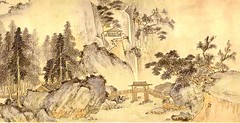Dots are very useful in landscape painting. Here's another segment of the Daijin painting of the previous blog post. It provides examples of various dot patterns. To do dots, it is helpful to do them in clusters. Examples of such are shown in the next blog. Just note that in this painting, the trees towards the left are done with a dot pattern of a 4-cluster. The tree toward the right, above the bridge, can be considered to consist of a flower cluster of 5 (though the picture is too fuzzy to make out with confidence). The rocks and landmasses are crowned with dot patterns as well. It is useful to think of these also as consisting of distinct clusters; a 5-cluster appears to work in most cases.
Then there are the overhanging trees in the upper part of the picture. One has vertical strokes for leaves, and the other has horizontal strokes. These are typically done with a dry brush, with the bristles somewhat splayed apart. Note that these linear strokes fall also under the category of dots. "Dots" in Chinese painting is a broad concept.
In the next blog we discuss how to do these dots.
Subscribe to:
Post Comments (Atom)



No comments:
Post a Comment